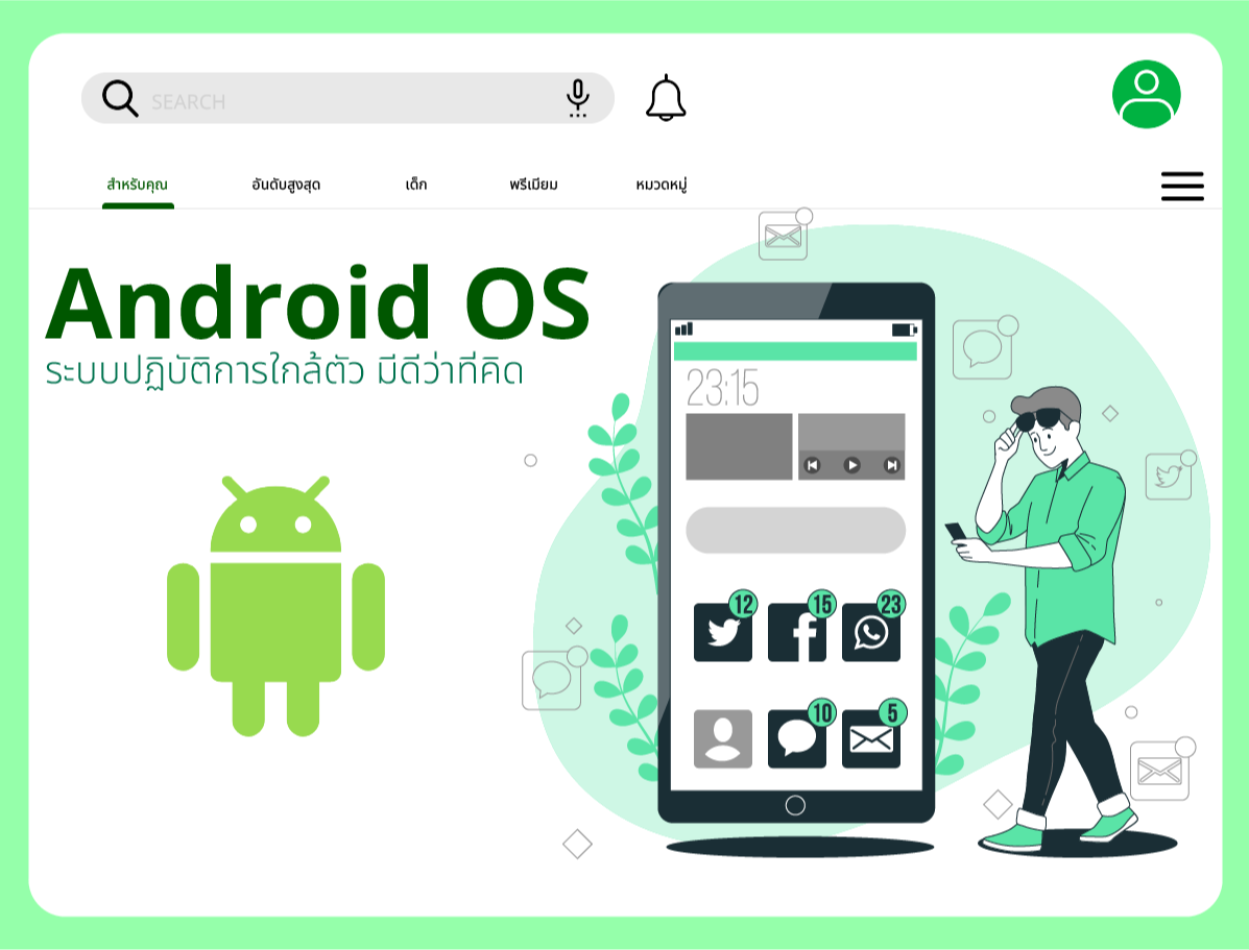
Android OS, is the closest operating system Theres a diva who thinks
2023-10-06 11:51:36
Android OS, is the closest operating system There's a diva who thinks
Android OS is a Linux operating system for smartphones and tablets. It uses the Linux kernel, GUI, and web browser. and applications to download Initial demos of Android use a normal QWERTY smartphone and a large VGA screen, but the operating system is written for low-cost phones.
The Andriod OS is an open-source Apache v2; It can be developed as an operating system for many devices, such as game consoles and Android digital cameras. Most Android apps come pre-installed with applications such as Google Maps, YouTube, Google Chrome, and Gmail.
History of Andriod OS
Android began as a Palo Alto startup called Android Inc. in 2003 as a system for digital cameras. But they dropped out due to competition. Google later acquired Android Inc. in 2005 for at least $50 million to market its early mobile platform to manufacturers. smartphone has the advantage of flexibility and upgradeability.
In 2007, a competitor to the Android OS was launched, the IOS system, which is an operating system for the iPhone from Apple. Previously, Android had a similar look to BlackBerry, which used a keyboard inside the device's screen, not a touch screen. But with the release of the iPhone, which changed the mobile phone market considerably, Android had to turn to developing a touch screen. But the first mobile phone to use the Android system and was first sold on the market was the HTC Dream, released in 2008.
In late 2007, the Open Handset Alliance (OHA) was announced. OHA is a coalition of more than 30 hardware, software, and telecommunications companies, including Google, Qualcomm, Broadcom, HTC, Intel, Samsung, Motorola, Sprint, Texas Instruments, and Japanese wireless carriers KDDI and NTT DoCoMo aim to develop the first open-source platform for mobile.
Google later released Andriod version 1.0, a beta version, around the same time as the alliance was founded. There was continuous development until 2009 when Andriod version 1.5 was released in the form of a nickname, Dessert, which Google gave the reason for. "Because these devices make our lives so sweet, each version of Android is named after a dessert."
Version | nickname |
Android 1.5 | Cupcakes |
Android 1.6 | Donuts |
Android 2.0-2.1 | Eclair |
Android 2.2 | froyo |
Android 2.3.3 | Gingerbread |
Android 3.0-3.2 | Honeycomb |
Android 4.0-4.0.3 | Ice Cream Sandwich |
Android 4.1-4.3 | Jelly bean |
Andriod 4.4-4.4w | KitKat |
Android 5.0-5.1 | Lollipop |
Android 6.0 | Marshmallow |
Android 7.0-7.1 | Nougat |
Android 8.0-8.1 | Oreo |
Android 9.0 | Pie |
Android 10 | Queen Cake |
Android 11 | Red Velvet Cake |
Android 12 | Shaved ice |
Android 13 | Tiramisu |
Android 14 | Upside Down Cake |
Android Features
Android's default UI relies on direct manipulation inputs such as taps, swipes, and pinches to initiate actions. The device provides users with haptic feedback through notifications, such as vibrations in response to various actions. If the user presses the navigation button The device will vibrate, etc. Android will display the Home screen, which is a navigation menu for Android that includes widgets and app icons. which can be customized according to the use
of Android OS version
Android 1.0 was released on September 23, 2008. Includes a suite of Google apps including Gmail, Maps, Calendar, and YouTube.
Android 1.5 was released on April 27, 2009, introducing an on-screen touch keyboard and a framework for third-party app widgets.
Android 1.6 was released on September 15, 2009, bringing the operating system's ability to work on different screen sizes and resolutions. Added support for CDMA networks
Android 2.0-2.1 released on Oct 26, 2009, added turn-by-turn voice navigation. Real-time traffic information Ability to pinch to zoom
Android 2.2 released on May 20, 2010 Added the commands below. and voice commands This allows users to tap icons and speak commands. Flash support was also introduced to web browsers.
Android 2.3.3 released on December 6, 2010, introduced black and green colors in the UI.
Android 3.0-3.2 was released on February 22, 2011. This version is tablet-specific and introduces a blue space-themed holographic design.
Android 4.0-4.0.3 released on Oct 18, 2011, introduced a unified UI for both tablets and smartphones. Focus on swiping as a navigation method.
Android 4.1-4.3 released on July 9, 2012, November 13, 2012, and July 24, 2013, respectively, launched Google Now, a daily planning service. Added interactive notifications and improved voice search.
Andriod 4.4-4.4w released on October 31, 2013, introduced brighter colors in the UI with a transparent status bar and white icons.
Android 5.0-5.1, released on November 12, 2014, incorporates a card-style look in the design with elements such as notifications and a recent app list. Launch hands-free voice control with the command "OK Google"
Android 6.0 was released on October 5, 2015. This release adopts Google's annual release schedule, introducing finer-grained app permissions and support for USB-C and fingerprint readers.
Android 7.0-7.1, released on August 22, 2016, and October 4, 2016, respectively, introduced native split-screen mode and the ability to integrate app-based notifications.
Android 8.0-8.1 was released on August 21, 2017, and December 5, 2017, respectively. These versions introduced native picture-in-picture (PIP) mode and the ability to mute notifications temporarily. Oreo was the first version to include Project Treble, which OEM efforts to provide more standardized software updates
Android 9.0 was released on August 6, 2018. This version replaces the back, home, and overview buttons with smaller multifunction home and back buttons. Launch of productivity enhancement features Includes suggested replies to messages and the ability to manage brightness.
Released on September 3, 2019, Andriod 10 abandons the back button in favor of swipe-based navigation. Introducing Dark Theme and Focus Mode helps users limit distractions from certain apps.
Android 11 released on September 8, 2020, adds built-in screen recording. Create a single place to respond. Conversations across multiple messaging apps This version also updates chat bubbles to allow users to pin conversations to the top of apps and screens.
Android 12 released on Oct 4, 2021, adds customization options for the user interface. Conversation widgets allow users to store their preferred contacts on their home screen. Add more privacy options This includes sharing when an app accesses information like your camera, photos, or microphone.
Andriod 12L was released on March 7, 2022. The L stands for a larger screen. This update is intended to improve the user interface and optimize performance for larger screens of tablets, convertibles, or Chromebooks. This update adds a dual-panel notification center for Tablets and convertibles
Android 13, released on Aug 15, 2022, includes more customization options like colors, themes, languages, and music. Security updates include controls over what data apps can access. Notification permission is required for all apps. and clearing personal information on the clipboard This update enables multitasking by sharing messages, chats, links, and photos across multiple Android devices, including phones, tablets, and Chromebooks.
Android 14 released on Oct 4, 2023, adds more customizable wallpaper themes and app icons. Increase font size up to 200%. Predictive Back can be set manually. You can choose to capture some screenshots. The camera will have intelligence in processing photos. More accurate in language translation And adding features to track quality and exercise can connect to other devices that support Google Play.
What devices can Andriod be used on?
Android uses ARM for its hardware platform. Newer versions of the Android operating system support x86 and x86-64. Since 2012, device manufacturers have released Android smartphones and tablets based on Intel processors.
The minimum hardware specs to run Android are a 200 MHz processor, 32 MB of storage, and 32 MB of RAM.
Comparison between Andriod and other systems
Android OS | IOS | ONE OS | ColorOS | EMUI OS |
Developed by Google | Developed by Apple | Developed by Samsung | Developed by OPPO | Developed by Huawei |
Used in many brands of smartphones, high market share | Use on iPhone, iPad, Apple Watch | Used in Samsung smartphones, Galaxy Tab, Galaxy watch | Used in OPPO and Realme | Used in Huawei and Honor |
- | - | Developed from Android OS | Developed from Android OS | Developed from Android OS |
In summary, Android OS is an operating system built as an open-source mobile operating system. that is popularly used around the world Can be used on many devices including mobile phones, tablets, cameras, etc. It was developed by Google and is very popular today.
Leave a comment :
Recent post

2025-01-10 10:12:01

2024-05-31 03:06:49

2024-05-28 03:09:25
Tagscloud
Other interesting articles
There are many other interesting articles, try selecting them from below.

2024-04-08 01:06:31

2024-04-25 09:31:48

2023-09-12 05:34:35

2024-12-03 04:32:17

2024-11-25 02:19:13

2024-05-08 03:52:01

2024-08-06 10:34:57


